| Author |
Message |
|
Ken Speed
|
 Posted: Fri 18 Nov, 2011 5:35 am Post subject: Posted: Fri 18 Nov, 2011 5:35 am Post subject: |
 |
|
Elling Polden wrote, ""]In the sagas, the word "broad axe" is used to describe the wide, long edged, thin profile, axes we would call daneaxes. Their counterpart where wedge axes, which have a narrow, short edged wedge profile.
The leidang laws spesificaly forbid the use of felling axes, but equates a broad axe with a sword."
OK, you'll get no argument from me. I have no idea what the presumably Rus owner of that particular axe called it or, for that matter, what they used it for. The museum seems to think that the artifact is a weapon and maybe they know something I don't or see something I can't but what I see says that axe was made to be used as a tool not a weapon.
|
|
  |
 |
Elling Polden

|
 Posted: Fri 18 Nov, 2011 6:28 am Post subject: Posted: Fri 18 Nov, 2011 6:28 am Post subject: |
 |
|
Ken: Just clarifying the use of terms. Which is often confusing as the use of a word can change A LOT in 1000 years.
Will: Presumably you would find both kinds; the 4 ft "Hand and a half axe" version as a acessory to a spear and shield kit, or a personal defence weapon, and the long battlefield version.
The varangian guardsmen, saxon huskarls or galloglass, having the axe as a primary weapon, would probably use the long hafted version. Norse raiders would go for the shorter one.
"this [fight] looks curious, almost like a game. See, they are looking around them before they fall, to find a dry spot to fall on, or they are falling on their shields. Can you see blood on their cloths and weapons? No. This must be trickery."
-Reidar Sendeman, from King Sverre's Saga, 1201
|
|
    |
 |
|
Gary Teuscher
|
 Posted: Fri 18 Nov, 2011 9:02 am Post subject: Posted: Fri 18 Nov, 2011 9:02 am Post subject: |
 |
|
| Quote: | | The varangian guardsmen, saxon huskarls or galloglass, having the axe as a primary weapon, would probably use the long hafted version. Norse raiders would go for the shorter one. |
Think so? I think it would depend more upon the time period.
The Saxon huskarls were largely Danes, the varangians (depending on time period) were a mixture of Rus, Saxons (of Danish ancestory probably), Swedes and Norse.
I would think the elite Hird of Hardrada that used the axe would be using weapons similar to the Danish Huscarls they fought at Stamford Bridge.
And the gallowglass, first appearing under that name in the 13th century, were Hebridean and other islanders mostly, who were largely of Norse, though prior to that there were certainly ax wielding "viking" mercenaries from the Hebrides and other areas, that were again largely of Norse ancestory.
From what we have seen from illustrations, the 2 handed danish axe was in use by about the 10th century, possibly ealrier, with it gaining some length by about the 12th century and becoming more widespread in use throughout europe.
I'd think 9th-11th century Viking raiders, Saxon Huscarls and Varangians would be using the shorter version, with these users using longer weapons somewhere around the 12th century.
|
|
  |
 |
|
Ken Speed
|
 Posted: Fri 18 Nov, 2011 11:05 am Post subject: Posted: Fri 18 Nov, 2011 11:05 am Post subject: |
 |
|
[Gary wrote, "The Saxon huskarls were largely Danes..............."
????????????? How stupid of me, I always assumed they were Anglo Saxons!!!
Please explain why they weren't Anglo Saxon. Why would Harold Godwinsson rely on Danes to fight Harold Hardrada? Are you saying that their parents or grandparents settled in the Danelaw?
|
|
  |
 |
|
Gary Teuscher
|
 Posted: Fri 18 Nov, 2011 6:39 pm Post subject: Posted: Fri 18 Nov, 2011 6:39 pm Post subject: |
 |
|
| Quote: | | ????????????? How stupid of me, I always assumed they were Anglo Saxons!!! |
Wow....just a hint of sarcasm here I guess?
| Quote: | | Why would Harold Godwinsson rely on Danes to fight Harold Hardrada? |
I'll answer this with a question - Why would Byzantine kings rely on Nordic people to fight a wide vaqriety of opponents (Varangians)?
The "viking" people were used as mercenaries or a bodyguard by many cultures, Including Irish, Saxons and others.
I see no reason why it would be a suprise to use Danish against Norse - Cnut conquered Norway, which then won it's independence. I would think many Norwegians resented the Danish conquest, and the Danes were not to happy losing Norway back to the Norwegians. Hardrada had running battles against the Danes in the early part of his kingship.
Anyway, these mercenaries or housetroops, depending on what you call them seem to have been pretty loyal to their various employers, perhaps why they were in demand.
| Quote: | | Are you saying that their parents or grandparents settled in the Danelaw? |
I'll refrain from sarcasm and just answer with a simple yes.
The military heritage of the Saxon Huscarls was Danish - and many were indeed Danish. A group of English noblemen, likley many Danes as well, offered the crown of England to the Danish King after the conquest if he would invade. There were likely many Danes in the group. From 1016 to 1042 Danes ruled the Kingdom until Edward the Confessor took the throne. The Danelaw was established in 884. I think there was plenty of time for Danes to become part of Englands political scene.
And this military heritage of the Danish included the Danish axe, which was similar to the other "viking" types. And interestingly enough, of Cnut's army, Norwegians made up a portion, so the heritage was mixed Danish/Norwegian.
I'd like to find a list of the actual Saxon Huscarl names. I'd think you would find many Danish names in there.
|
|
  |
 |
David Huggins

|
|
   |
 |
|
William P
|
 Posted: Sat 19 Nov, 2011 12:40 am Post subject: Posted: Sat 19 Nov, 2011 12:40 am Post subject: |
 |
|
| Gary Teuscher wrote: | | Quote: | | The varangian guardsmen, saxon huskarls or galloglass, having the axe as a primary weapon, would probably use the long hafted version. Norse raiders would go for the shorter one. |
Think so? I think it would depend more upon the time period.
The Saxon huskarls were largely Danes, the varangians (depending on time period) were a mixture of Rus, Saxons (of Danish ancestory probably), Swedes and Norse.
I would think the elite Hird of Hardrada that used the axe would be using weapons similar to the Danish Huscarls they fought at Stamford Bridge.
And the gallowglass, first appearing under that name in the 13th century, were Hebridean and other islanders mostly, who were largely of Norse, though prior to that there were certainly ax wielding "viking" mercenaries from the Hebrides and other areas, that were again largely of Norse ancestory.
From what we have seen from illustrations, the 2 handed danish axe was in use by about the 10th century, possibly ealrier, with it gaining some length by about the 12th century and becoming more widespread in use throughout europe.
I'd think 9th-11th century Viking raiders, Saxon Huscarls and Varangians would be using the shorter version, with these users using longer weapons somewhere around the 12th century. |
so in other words, if im a 10th century varangian. my axe should be no bigger than say 130cm (4 feet is 120)
as for why the varangians becoming the imperial guardsmen
being a mercenary in itself doesnt guarentee loyalty, the condotierii are a famous example since being a mercenary your only there for the pay, really, and its feasible someone could offer you a better deal. it was the fact that, being foreigners, they had no loyalty to the various provincial barons. this is why the emporer didnt have local troops, because they, or at least their commander, being of local stock, would be able to be influenced by the various power games by the barons. the varangians were apolitical
their recruitment was part of a series of events that also resulted in the converson of the rus to chrstianity. after some clashes with the byzantines, they i think later helped them, and the rus king or jarl or whatever rank he was, essentially said 'have some of my men to protect you'
they werent loyal to the man on the throne, but they were assigned to protect the TITLE of the emperor
a good example of this was when the varangians were told of the emporer being in peril. they ran to his aid. by the time they arrived he was dead. they immediately knelt at the feet of the one who killed him, a man who happened also to be the heir to the throne, since they had no obligation to the previous man (for arguements sake well call michael) they protected the emporer, not michael, once michael is dead hes no longer emporer, and thus they felt no obligation to him anymore, and since his attacker was now automatically emporer, they now had to protect him, even if he just killed the man they WERE protecting just a minute ago,
they also supposedly had the right to run to the royal treasury and take what they could carry when the empoer died i dont know how much loot or how many could take stuff at once.
(i THINK they could do that, id need to double check)
the rus were fearsome fighters, thus were physically up to the task of defending the emperor from attackers either on the battlefield or just day to day (the first 'batch' of guardsmen in the last 20-30 years of the 10th centurywould have been pretty much ALL rus. )
|
|
   |
 |
Jean Thibodeau

|
 Posted: Sat 19 Nov, 2011 12:55 am Post subject: Posted: Sat 19 Nov, 2011 12:55 am Post subject: |
 |
|
| William P wrote: |
being a mercenary in itself doesnt guarentee loyalty, the condotierii are a famous example since being a mercenary your only there for the pay, really, and its feasible someone could offer you a better deal. it was the fact that, being foreigners, they had no loyalty to the various provincial barons. this is why the emporer didnt have local troops, because they, or at least their commander, being of local stock, would be able to be influenced by the various power games by the barons. the varangians were apolitical
their recruitment was part of a series of events that also resulted in the converson of the rus to chrstianity. after some clashes with the byzantines, they i think later helped them, and the rus king or jarl or whatever rank he was, essentially said 'have some of my men to protect you'
they werent loyal to the man on the throne, but they were assigned to protect the TITLE of the emperor
a good example of this was when the varangians were told of the emporer being in peril. they ran to his aid. by the time they arrived he was dead. they immediately knelt at the feet of the one who killed him, a man who happened also to be the heir to the throne, since they had no obligation to the previous man (for arguements sake well call michael) they protected the emporer, not michael, once michael is dead hes no longer emporer, and thus they felt no obligation to him anymore, and since his attacker was now automatically emporer, they now had to protect him, even if he just killed the man they WERE protecting just a minute ago,
|
As to Italian Renaissance Mercenaries their ethics or lack of ethics is very different from the ethics of the Varangian guardsmen.
If they had arrived before the old Emperor was killed they would have defended him fiercely, but since he was dead the mantle had already passed to someone else so they could honourably continue defending the Emperor even if this was a " New Emperor " I think. They also where not lawyers who would argue the legitimacy of the new Emperor and they where not in a position to choose the Emperor themselves: If they had the power to choose the Emperor they would no longer have been an impartial and trusted guard but instead would have become corrupted by the power to choose or depose an Emperor.
At least this is the way I interpret the situation ..... but I could be wrong.  
You can easily give up your freedom. You have to fight hard to get it back!
|
|
  |
 |
|
William P
|
 Posted: Sat 19 Nov, 2011 2:24 am Post subject: Posted: Sat 19 Nov, 2011 2:24 am Post subject: |
 |
|
| Jean Thibodeau wrote: | | William P wrote: |
being a mercenary in itself doesnt guarentee loyalty, the condotierii are a famous example since being a mercenary your only there for the pay, really, and its feasible someone could offer you a better deal. it was the fact that, being foreigners, they had no loyalty to the various provincial barons. this is why the emporer didnt have local troops, because they, or at least their commander, being of local stock, would be able to be influenced by the various power games by the barons. the varangians were apolitical
their recruitment was part of a series of events that also resulted in the converson of the rus to chrstianity. after some clashes with the byzantines, they i think later helped them, and the rus king or jarl or whatever rank he was, essentially said 'have some of my men to protect you'
they werent loyal to the man on the throne, but they were assigned to protect the TITLE of the emperor
a good example of this was when the varangians were told of the emporer being in peril. they ran to his aid. by the time they arrived he was dead. they immediately knelt at the feet of the one who killed him, a man who happened also to be the heir to the throne, since they had no obligation to the previous man (for arguements sake well call michael) they protected the emporer, not michael, once michael is dead hes no longer emperor, and thus they felt no obligation to him anymore, and since his attacker was now automatically emporer, they now had to protect him, even if he just killed the man they WERE protecting just a minute ago,
|
As to Italian Renaissance Mercenaries their ethics or lack of ethics is very different from the ethics of the Varangian guardsmen.
If they had arrived before the old Emperor was killed they would have defended him fiercely, but since he was dead the mantle had already passed to someone else so they could honourably continue defending the Emperor even if this was a " New Emperor " I think. They also where not lawyers who would argue the legitimacy of the new Emperor and they where not in a position to choose the Emperor themselves: If they had the power to choose the Emperor they would no longer have been an impartial and trusted guard but instead would have become corrupted by the power to choose or depose an Emperor.
At least this is the way I interpret the situation ..... but I could be wrong.   |
you described the varangians attitude to the empoeror better than i could
thats what i was trying to get at i.e theyd defend an emporer to the last man but if he dies before they reach him. well, hes not the emporer anymore is he. so they have no reason to defend him.
my point about the condotieri is they are an example that just because your in one armies pay, doesnt automatically mean your reliable if anything the act of being a mercenary alone means your only motive for being there is getting the best pay, which means you, like the italians could be essentially sell yourselves to another army if they enticed you with a better deal (which they did, numerous times, sometimes switching sides halfway through a battle. (imagine that had happened at the battle of vernuil, where around 1-2000 italian mercenaries in full, top of the range milanese harnesses with plate barded horses, recruited by the french, smashed up the usually hard to dislodge english longbow emplacements)
it would have shocked the french quite a bit for them to suddenly see their new juggernauts wheel around in mid charge and whack their former employers instead of the english.
the varangians were different, not ONLY were they mercenaries, meaning they had a stake in keeping the emperor alive since he paid them. (though so would his successor) but they were also quite loyal from what i understand and of course didnt care about the power games played by the local greeks (is it just me or do the greeks seem to have a penchant for being decietful and underhanded..  ) )
the other extreme is like with the samurai, or the saxon huskarls at hastings. where, supposedly honour dictated that once harold died, they couldnt leave the field (why they didnt just carry his body from the field ill never know.. )and as a result, were killed to the last man...
|
|
   |
 |
|
Gary Teuscher
|
 Posted: Sat 19 Nov, 2011 8:56 am Post subject: Posted: Sat 19 Nov, 2011 8:56 am Post subject: |
 |
|
| Quote: | | the other extreme is like with the samurai, or the saxon huskarls at hastings. where, supposedly honour dictated that once harold died, they couldnt leave the field (why they didnt just carry his body from the field ill never know.. )and as a result, were killed to the last man... |
A am not aware of the Saxon Huscarls "being killed to the last man" at Hastings. There were still a lrge number of them around after Hastings, and I think Harold mobilized much of the Royal Huscarls for this campaign. They took a lot of casualties, but they routed like other soldiers once the battle was pretty well decided.
I'd also like to say something about the saxon Huscarls and their Danish ancestory - The ancestory of the Huscarls was probably mostly Danish, a little Norse and some Swedes, and I would not be suprised if there were a fair amount of those of true Saxon descent among them, much in the way later crusader armies had european "turkopole" troops mixed with native turkopoles. This is based on a names list of the troops, forgot where I read it, but there were many european names among the turkopole list of troops. Heck, it would not shock me if there was the occasional Irishman or Scot among the Royal Housecarls.
But the point is - in reference to the axe they would be using - the MILITARY ancestory of the troops was based on the Danish Huscarl model - and actually, it was less than 30 years prior to Hastings that these actually were Danes, ruled by a Danish King. And for purposes of the type of ax they would be using, it would be based on Danish (and likley Norse and Swede as well) model.
The "viking" armies of the time were often a polygot of various scandavavians, including islanders from the Hebrides and other islands. It was not unusual for a force of mixed danes and norse to be fighting another army of mixed danes and norse, though one side might be more danes, the other more norse. And neither might be fighting for their home country 
My whole point though is that the scandavavian/danish troops/armies/huscarls/hird of the time were often intermixed, and their weaponry I would expect to be very similar. We know Hardrada had a Norse hero at Stamford Bridge holding off Saxons at the bridge with a two handed axe - we just don't know how predominant the use of the 2 handed axe was among the Norse Hird. I would think it was common, but we really do not know.
One thing of interest that points to the use of mercenaries even by Hardrada - bases on conservative estimates of the size of his army in the English 1066 campaign, and the estimated population of Norway at the time - if all of these were Norse, he mobilized 1/20 Norwegians for the battle. Assuming 50% were female, and some were not of military age, that mobilizing about one in every 4 adult males, which is an incredibly high number.
Based on the fact he had some that were unhappy with his rule in Norway (he had put down some rebellions just prior to 1066), and that relations with Denmark were in essence an uneasy truce, this is far too high of a mobilization.
It is stated that some were not from Norway, but I would think that 25-40% would not be Norwegian, just as a guess.
|
|
  |
 |
|
Ken Speed
|
 Posted: Sat 19 Nov, 2011 10:11 am Post subject: Posted: Sat 19 Nov, 2011 10:11 am Post subject: |
 |
|
William wrote, "the other extreme is like with the samurai, or the saxon huskarls at hastings. where, supposedly honour dictated that once harold died, they couldnt leave the field (why they didnt just carry his body from the field ill never know.. )and as a result, were killed to the last man.."
To my knowledge the huscarls (whatever their lineage) were not wiped out to the last man and were not required to die on the field if their king was killed they did however take heavy casualties. The general thought appears to be that if the fyrd hadn't broken ranks the battle may very well have turned out differently. It seems also that after the fyrdmen broke ranks and went after the retreating forces of William of Normandy the huscarls didn't have enough men to maintain their shield wall.
Even though Harold's side lost the battle the English were able to maul their pursuers when they staged an ambush on ground that was difficult for horsemen ( a ditch or small valley of some sort?)
The battle is literally a cautionary tale on the lack or loss of discipline among the troops. William's men broke and fled when they were unable to break the shield wall tactics with archery and cavalry and Harold's fyrdmen broke their shield wall and lost the battle for him when they saw William's forces fleeing.
|
|
  |
 |
|
Gary Teuscher
|
 Posted: Sat 19 Nov, 2011 10:39 am Post subject: Posted: Sat 19 Nov, 2011 10:39 am Post subject: |
 |
|
| Quote: | | The battle is literally a cautionary tale on the lack or loss of discipline among the troops. William's men broke and fled when they were unable to break the shield wall tactics with archery and cavalry and Harold's fyrdmen broke their shield wall and lost the battle for him when they saw William's forces fleeing. |
I agree except for a few things - the flight of the Norman cavalry MAY have been feigned flight, moreso of this being done by the Bretons on the Norman right.
Though I think it was not feigned, even though the results were similar 
But the other thing about the Norman cavalry retreat - they were not having much sucess with the Saxon line, so instead of losing a lot of cavalry in this attempt flight to try again may have been the best option, may have even been ordered by William.
Of course, they may have just routed as well.
And as to the Saxons - I think they showed great discipline actually for the most part - they were under arrow fire and did not go after the archers - they routed the Norman infantry at least once, and IIRC it was the third attempt by the cavalry to break them when they finally went after the fleeing Norman cavalry.
This based on other troops repsonses in battles appears to show pretty good discipline - I think the Saxons knew what would work the best form them, staying as an immoblie defense against Norman attacks.
Having the Huscarls in the front ranks may have attributed to this discipline as well.
|
|
  |
 |
David Huggins

|
 Posted: Sat 19 Nov, 2011 8:55 pm Post subject: Dane axes Posted: Sat 19 Nov, 2011 8:55 pm Post subject: Dane axes |
 |
|
Gary
According to M.K.Lawson, probably the post published author on the subject of Cnut the Great, in his book 'Cnut;The Danes in England in the early eleventh century' relates that of the thirty two known named eleventh century housecarls, twenty eight have Scandinavian names.
Of course Scandinavian names continue well into the 12th century and are particularly common in the areas of the old Danelaw.
best
Dave
and he who stands and sheds blood with us, shall be as a brother.
|
|
   |
 |
Luka Borscak

|
 Posted: Mon 21 Nov, 2011 4:12 am Post subject: Posted: Mon 21 Nov, 2011 4:12 am Post subject: |
 |
|
My axe is finally here.  The maker is Alojz Krišto from Croatia. The head of the axe weighs about 800 grams according to Alojz, but I don't know exactly how much it is overall. Anyway, it is very fast and agile for an axe, especially in two handed grip. The construction is historically accurate 3 piece construction, eye and main body are two pieces of some lower carbon steel, unhardened, and the edge is hardened D2 tool steel. The axe head is left black from the forge, except the edge, and I'm still undecided if I want it polished or not. I know polished might be more historically accurate, but I really like dark grey and bronze colors produced by the heat. Haft is at the moment short, 30" ash haft, but as soon as Alojz gets a longer piece of ash, it will be replaced with one of about 4 feet. Here are the pictures: The maker is Alojz Krišto from Croatia. The head of the axe weighs about 800 grams according to Alojz, but I don't know exactly how much it is overall. Anyway, it is very fast and agile for an axe, especially in two handed grip. The construction is historically accurate 3 piece construction, eye and main body are two pieces of some lower carbon steel, unhardened, and the edge is hardened D2 tool steel. The axe head is left black from the forge, except the edge, and I'm still undecided if I want it polished or not. I know polished might be more historically accurate, but I really like dark grey and bronze colors produced by the heat. Haft is at the moment short, 30" ash haft, but as soon as Alojz gets a longer piece of ash, it will be replaced with one of about 4 feet. Here are the pictures:
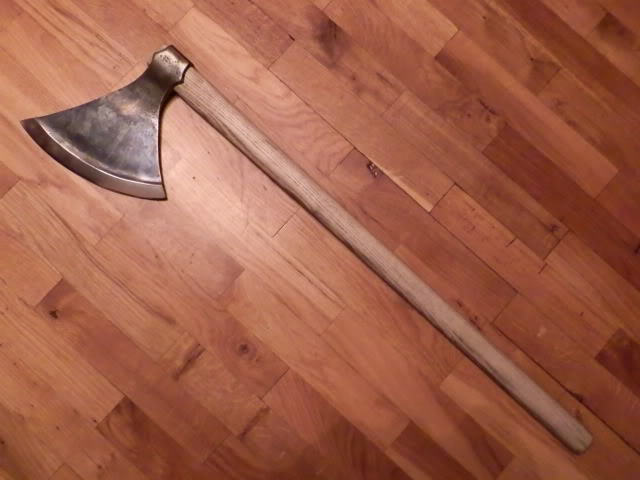
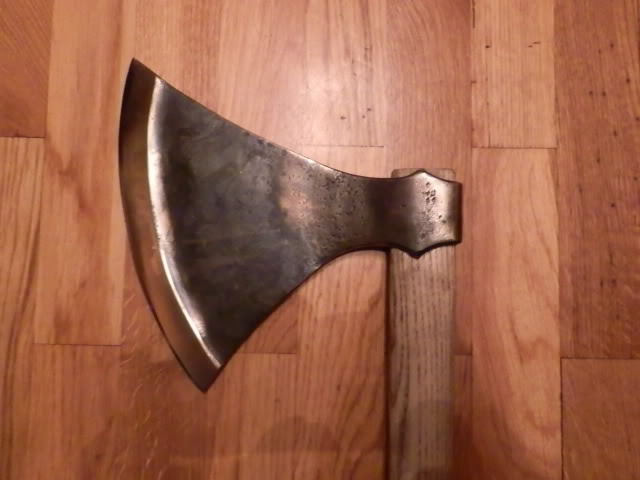
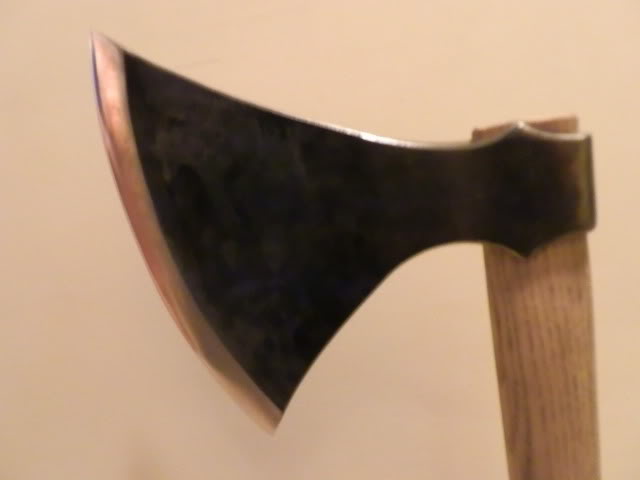
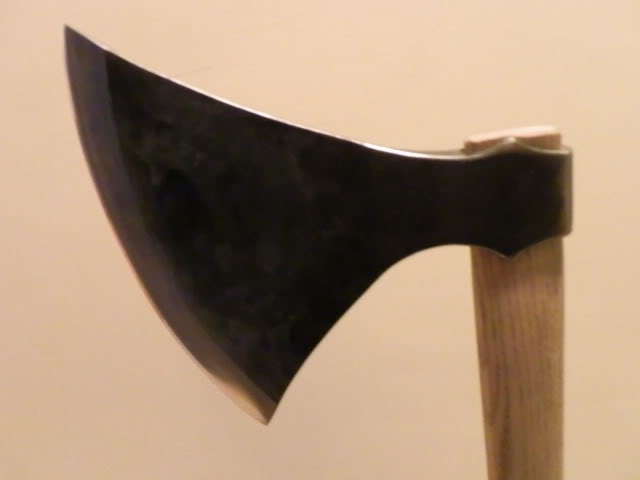
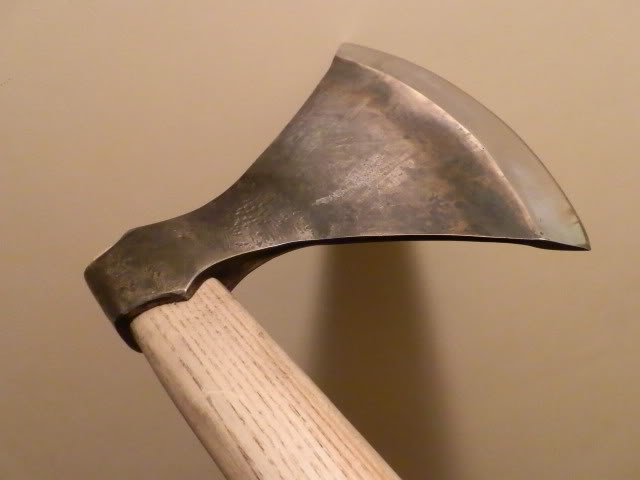
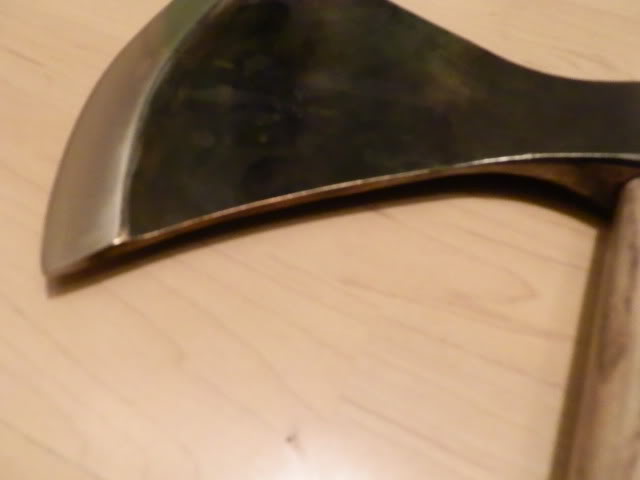
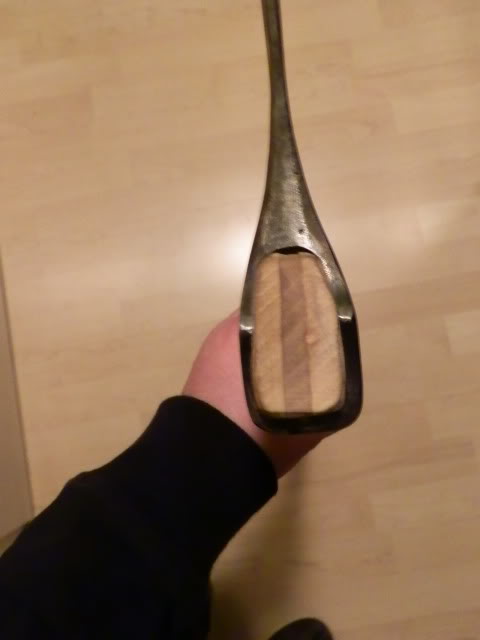
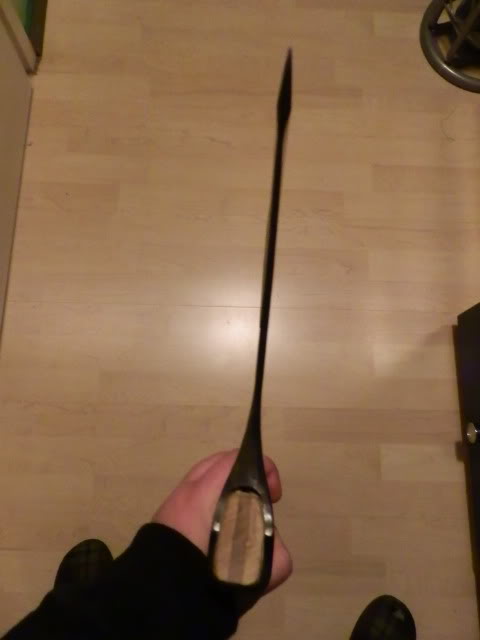
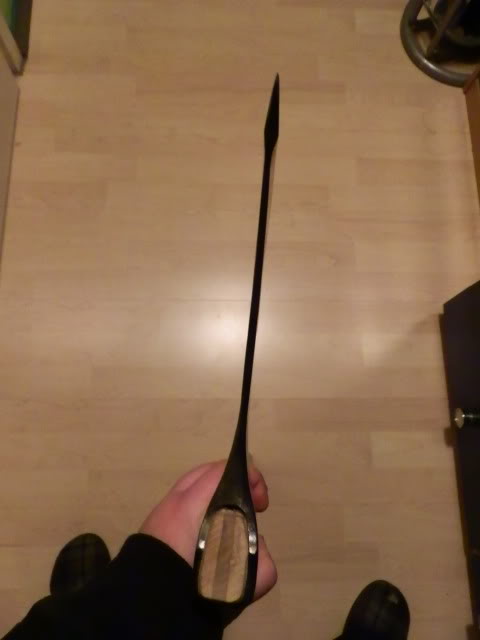
|
|
  |
 |
|
Ken Speed
|
 Posted: Mon 21 Nov, 2011 10:18 am Post subject: Posted: Mon 21 Nov, 2011 10:18 am Post subject: |
 |
|
Luka,
Congratulations, you're a lucky man and the smith who made it is clearly highly skilled. I bet you'll be even happier with it when you get the longer haft. For what its worth, I wouldn't polish it I think it looks great just as it is.
|
|
  |
 |
Luka Borscak

|
 Posted: Mon 21 Nov, 2011 12:50 pm Post subject: Posted: Mon 21 Nov, 2011 12:50 pm Post subject: |
 |
|
|
Thanks Ken! Alojz is a great craftsman indeed. Longer haft will provide much more leverage and she'll be a real monster then...
|
|
  |
 |
Jean Thibodeau

|
 Posted: Mon 21 Nov, 2011 7:11 pm Post subject: Posted: Mon 21 Nov, 2011 7:11 pm Post subject: |
 |
|
I would be tempted to try a 5' haft or even longer and cut it shorter until it feels right to you: At the very least even if you still end up with a 4' haft you would get the knowledge of how the longer ones feel like and handle. 
4' is a good length for both one handed and two handed use although for one handed one may have to hold it mid haft for faster recovery but this is less important if one is depending on a shield for defence I think.
Oh, almost forgetting to complement you on a very nice looking axe.   
You can easily give up your freedom. You have to fight hard to get it back!
|
|
  |
 |
|
Ken Speed
|
 Posted: Mon 21 Nov, 2011 7:36 pm Post subject: Posted: Mon 21 Nov, 2011 7:36 pm Post subject: |
 |
|
Luka,
I don't know if you're planning on doing any test cutting with your new axe but if you do I'm sure we'd all be interested in your impressions of the handling and the like.
I cut some butternut squash with my Albion Knud and it was great fun! HMMMMMMMM........Are Hubbard squash cheap where you live? I remember when I was a child my grandfather would use a double bitted axe to split big ones. I think you'd be hard pressed to split one with the blade configuration of that axe but I think a Hubbard squash would be a really good test medium. Fun to do and fun to watch too!!!!
|
|
  |
 |
|
|
You cannot post new topics in this forum
You cannot reply to topics in this forum
You cannot edit your posts in this forum
You cannot delete your posts in this forum
You cannot vote in polls in this forum
You cannot attach files in this forum
You can download files in this forum
|
All contents © Copyright 2003-2024 myArmoury.com — All rights reserved
Discussion forums powered by phpBB © The phpBB Group
Switch to the Basic Low-bandwidth Version of the forum
|

